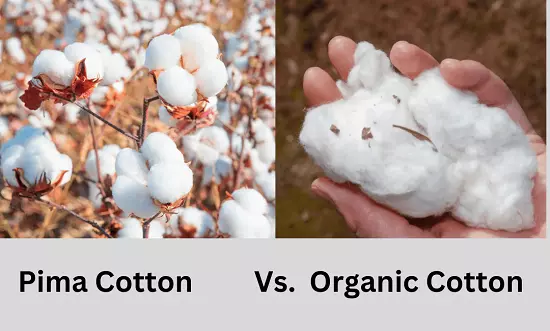Difference Between Pima Cotton and Organic Cotton
Introduction
We all know cotton because it’s soft and comfortable, right? But did you know there are four main types of cotton? Today, we’re focusing on the popular ones: Pima and organic cotton. They might seem similar, but trust me, there’s more than meets the eye. From where they grow to how they affect the environment, these two cotton types have their own stories. If you’re curious and want to understand the small but significant differences between Pima and organic cotton, you’re in the right place! This blog is all about making it easy for you. Let’s clear the clouds by understanding these two cotton buddies!

What is Pima Cotton?
Pima cotton, or Supima cotton, is a very soft fabric of long cotton strands. Most cotton varieties have comparatively short fibers; however, Pima cotton is one of the few varieties classified as extra-long staple (ELS) cotton, meaning its thread length exceeds 34 millimeters.
Gossypium barbadense, a particular cotton plant, makes Pima fabric and other ELS (Extra-Long Staples) cotton kinds. Only found in tropical regions, this variety of cotton is highly vulnerable to frost damage. It produces exceptionally long cotton fibers and becomes a little tree with vivid yellow blossoms.
What is Organic Cotton?
On the flip side, Organic cotton is grown using environmentally friendly processes and ingredients. Restoring and preserving soil fertility, lowering the usage of harmful and enduring pesticides and fertilizers, and fostering biologically varied agriculture are all achieved through organic agricultural techniques. Organizations that certify third parties attest that organic farmers employ only those techniques and substances permitted in organic farming. Synthetic fertilizers and hazardous, recurring insecticides are not used to cultivate organic cotton. Furthermore, utilizing genetically modified seeds in organic agriculture is against federal regulations. Strict federal rules governing cotton cultivation practices must be followed by all cotton sold as organic in America.
Pima Cotton and Organic Cotton: What Makes Them Different From Each Other?
Several factors make both of them different from each other;
Pima Cotton
- Luxurious Feel: Known for its soft and glossy texture.
- Long Fibers: Achieves superior quality through exceptionally long fibers.
- Origin: Named after the Pima Native American tribe, cultivated from the Gossypium barbadense plant.
- Weather: It is grown in dry regions; Australia, Peru, and the United States are significant producers.
- Variety: offers various types, each with unique features, such as Pima Sateen and Pima Twill.
Organic Cotton:
- Focus on Sustainability: Highlights environmentally sustainable farming methods.
- Abstains from Synthetic Chemicals: Grown without artificial fertilizers or pesticides.
- Natural Processes: Contains techniques such as using organic fertilizers and rotating crops.
- Respects moral work standards and ethical labor practices.
- Environmental Impact: Try to reduce any adverse effects on the ecosystem.
Simply put, Pima cotton shines with its softness and unique varieties, while organic cotton takes the spotlight for its commitment to sustainability and environmentally conscious cultivation. Each has its own story in the cotton narrative, catering to different preferences and values.
What kind of clothes are made by Pima Cotton?
Pima cotton is used in various clothing items because of its ease and softness. Pima cotton gives its smooth touch to different apparel items, from everyday necessities like t-shirts and underpants to bed sheets that promise a good night’s sleep. Because of its breathability and durability, it’s an excellent material for sportswear and undergarments that feels comfortable on the skin.
Pros and Cons of Pima Cotton
Pima cotton is famous because it’s long-lasting and incredibly soft. What’s the secret? Because of its extra-long fibers, your garments will seem polished and silky. But every coin has two sides, and the wrong side of Pima cotton is that its cultivation is not easy. It’s not eco-friendly for the environment because it requires particular weather and may use many resources. Therefore, even if Pima cotton feels excellent, it’s challenging to make it happen.
Pros and Cons of Organic Cotton
Environmentally conscious consumers are attracted to organic cotton due to its commitment to sustainability. It supports moral work practices and healthier ecosystems by doing away with the usage of hazardous chemicals. The lack of synthetic fertilizers and pesticides enhances the fertility and biodiversity of the soil. However, growing cotton organically has its drawbacks. The resources and careful attention to detail required to produce organic cotton frequently translate into a higher price tag.
Final Thoughts Choosing Fabric for a Better Tomorrow
As far as we’ve learned, there are notable distinctions between Pima Cotton and Organic Cotton, but deciding between the two doesn’t simply come down to personal preference. It’s similar to using your decisions to convey a responsible story. Whether you choose organic cotton for its eco-friendliness or Pima for its softness, each choice adds a new chapter to the ongoing story of fashion and responsibility. As consumers, we can change things. The small decisions we make now pave the way for a time when feeling good and doing the right thing will come naturally to us.
- Additionally, You would love to read: Advantages, Disadvantages, and Uses of Cotton Fiber
